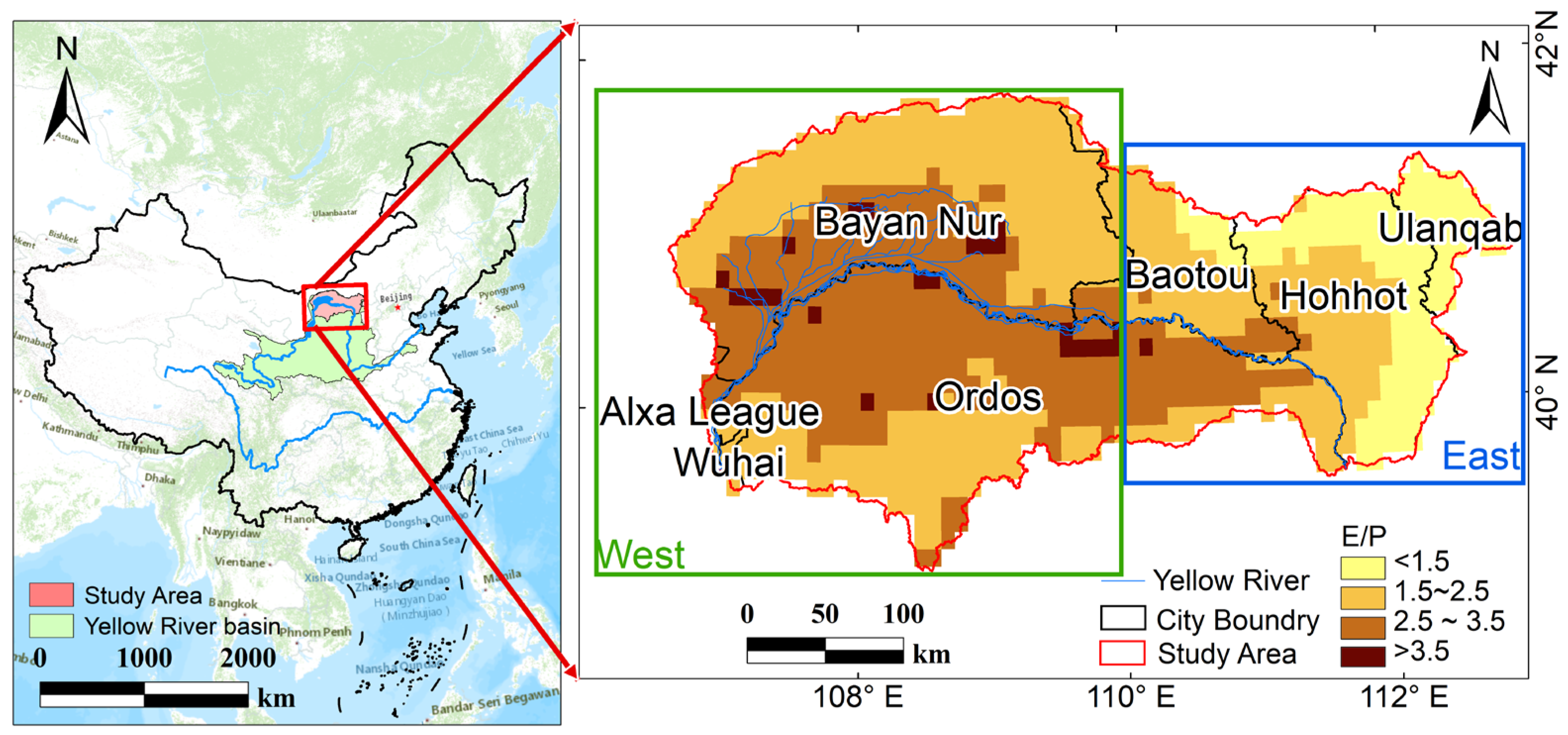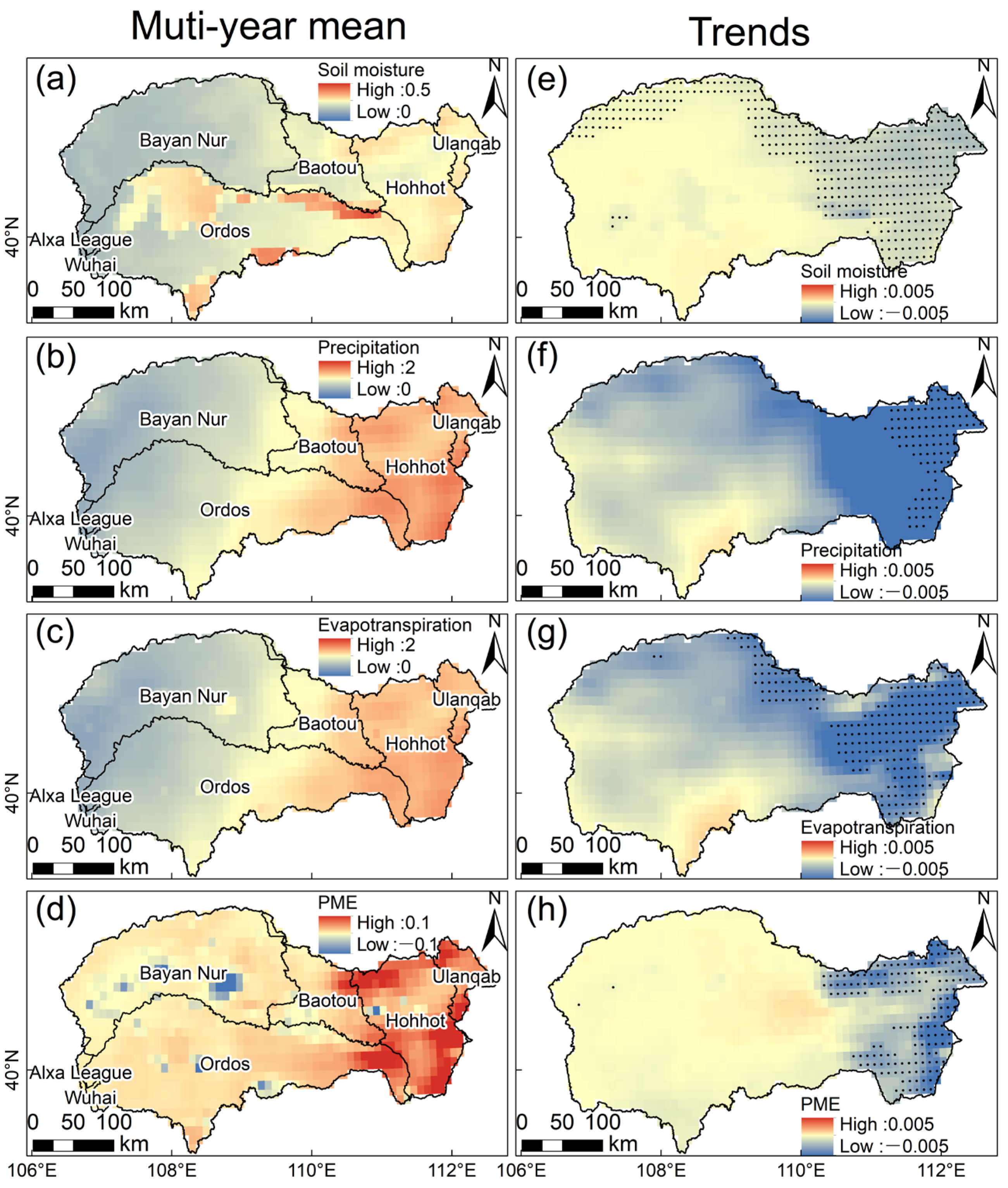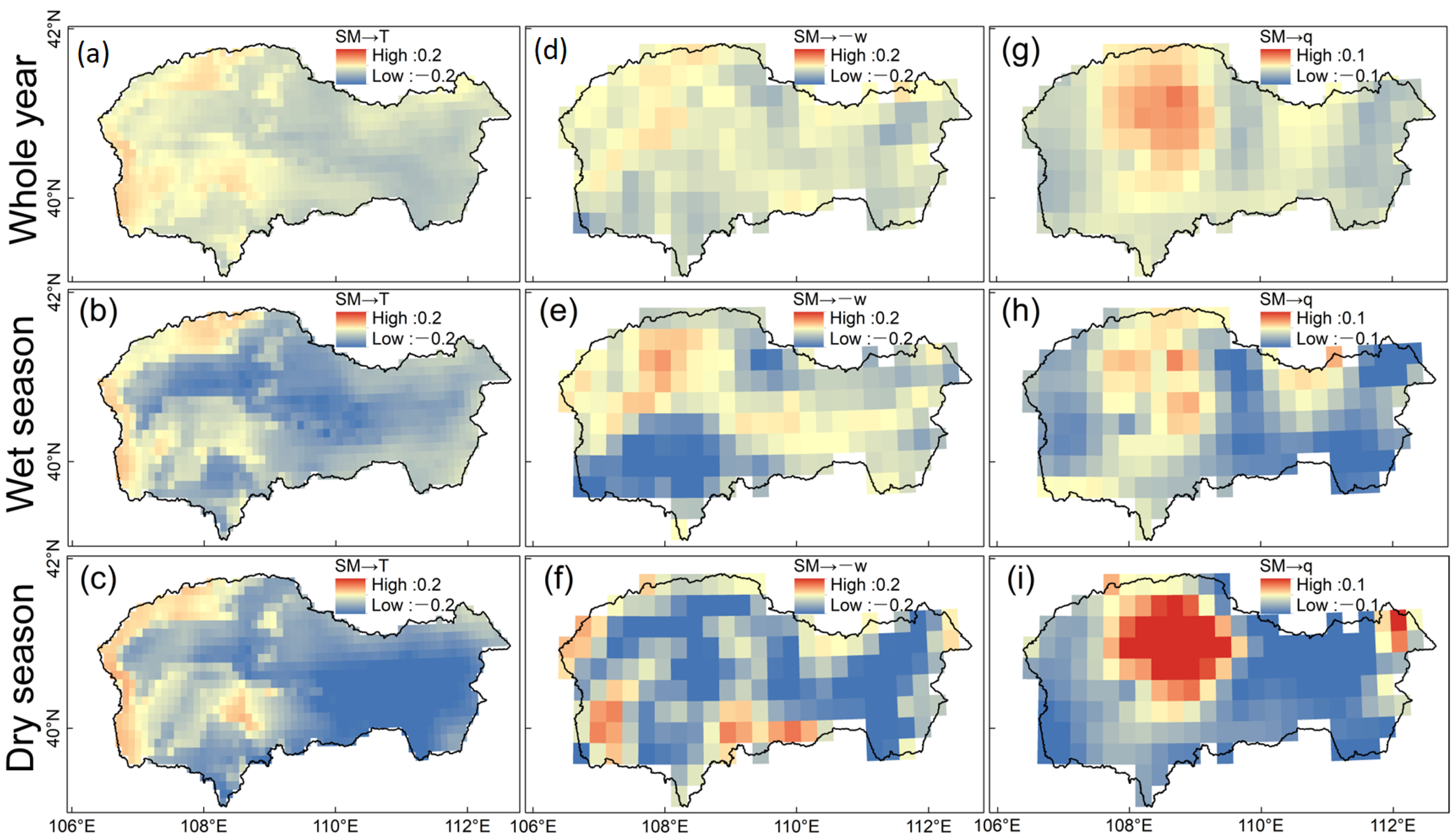Interactions between Soil Moisture and Water Availability over the Inner Mongolia Section of the Yellow River Basin, China
Abstract
1. Introduction
2. Materials and Method
2.1. Study Area
2.2. Data Sources
2.3. Research Method
- (1)
- Definition of the wet and dry seasons
- (2)
- Trend analysis
- (3)
- SM-atmosphere feedbacks
- (4)
- Decomposition of the atmospheric moisture convergence
3. Results
3.1. Spatial Pattern and Trends of the Meteorological Variables
3.2. Negative SM-PME Feedback during the Wet and Dry Seasons
3.3. Thermodynamics and Dynamic Effects in the SM-PME
4. Discussion
5. Conclusions
- (1)
- The IMYRB is located in an arid region, dry in the east and drier in the west. Monthly SM, evapotranspiration, precipitation, and PME all showed a spatial pattern of low values in the west and high values in the east, while the spatial pattern of the downward trend was significantly consistent (r = 0.7, p < 0.05). There is a strong interaction between SM and PME, the SM-PME negative feedback eased the PME decline in more than 90% of areas;
- (2)
- The SM-PME negative feedback occurs throughout the whole year and the feedback is greater in the wet season (n1-mean = −0.242) than in the dry season (n1-mean = −0.215), which is consistent with the existing dynamic and thermodynamic theories [54,55]. In the wet season, the SM-PME negative feedback appears due to the SM-E positive feedback (n1-mean = 0.179) and SM-P negative feedback (n1-mean = −0.10), and in the dry season, it is a combination of the positive feedback of the SM-E (n1-mean = 0.296) and SM-P (n1-mean = 0.024). The difference in the feedback degree of the SM-P feedback and SM-E feedback in the dry season and wet season caused the difference in feedback of the SM-PME in the dry season and wet season;
- (3)
- By quantifying the contributions of the dynamics and the thermodynamic component in the moisture convergence process under the wet and dry seasons, as well as the whole year, it can be seen that the dynamic mechanism promoted the water vapor convergence process, while the thermodynamic mechanism slowed down the process, and the contribution of the dynamics mechanism is slightly greater in the wet season (r = 0.86, p < 0.05) than the dry season (r = 0.85, p < 0.05).
Author Contributions
Funding
Institutional Review Board Statement
Informed Consent Statement
Data Availability Statement
Acknowledgments
Conflicts of Interest
References
- Zhang, Q.; Li, J.; Singh, V.P.; Xiao, M. Spatio-temporal relations between temperature and precipitation regimes: Implications for temperature-induced changes in the hydrological cycle. Glob. Planet. Chang. 2013, 111, 57–76. [Google Scholar] [CrossRef]
- Wang, G.; Zhang, Q.; Yu, H.; Shen, Z.; Sun, P. Double increase in precipitation extremes across China in a 1.5 °C/2.0 °C warmer climate. Sci. Total Environ. 2020, 746, 140807. [Google Scholar] [CrossRef] [PubMed]
- Wang, R.; Li, L.; Gentine, P.; Zhang, Y.; Chen, J.; Chen, X.; Chen, L.; Ning, L.; Yuan, L.; Lü, G. Recent increase in the observation-derived land evapotranspiration due to global warming. Environ. Res. Lett. 2022, 17, 024020. [Google Scholar] [CrossRef]
- Padrón, R.S.; Gudmundsson, L.; Seneviratne, S.I. Observational constraints reduce likelihood of extreme changes in multidecadal land water availability. Geophys. Res. Lett. 2019, 46, 736–744. [Google Scholar] [CrossRef]
- Swenson, S.; Wahr, J. Estimating large-scale precipitation minus evapotranspiration from GRACE satellite gravity measurements. J. Hydrometeorol. 2006, 7, 252–270. [Google Scholar] [CrossRef]
- Chen, Z.; Wang, W.; Cescatti, A.; Forzieri, G. Climate-driven vegetation greening further reduces water availability in drylands. Glob. Chang. Biol. 2023, 29, 1628–1647. [Google Scholar] [CrossRef]
- Shen, Z.; Zhang, Q.; Singh, V.P.; Pokhrel, Y.; Li, J.; Xu, C.Y.; Wu, W. Drying in the low-latitude Atlantic Ocean contributed to terrestrial water storage depletion across Eurasia. Nat. Commun. 2022, 13, 1849. [Google Scholar] [CrossRef]
- Fischer, E.M.; Seneviratne, S.I.; Vidale, P.L.; Lüthi, D.; Schär, C. Soil moisture–atmosphere interactions during the 2003 European summer heat wave. J. Clim. 2007, 20, 5081–5099. [Google Scholar] [CrossRef]
- Schwingshackl, C.; Hirschi, M.; Seneviratne, S.I. Quantifying spatiotemporal variations of soil moisture control on surface energy balance and near-surface air temperature. J. Clim. 2017, 30, 7105–7124. [Google Scholar] [CrossRef]
- Zhang, Q.; Fan, K.; Singh, V.P.; Sun, P.; Shi, P. Evaluation of remotely sensed and reanalysis soil moisture against in situ observations on the Himalayan-Tibetan Plateau. J. Geophys. Res. Atmos. 2018, 123, 7132–7148. [Google Scholar] [CrossRef]
- Williams, C.A.; Albertson, J.D. Soil moisture controls on canopy-scale water and carbon fluxes in an African savanna. Water Resour. Res. 2004, 40, 3208. [Google Scholar] [CrossRef]
- Entekhabi, D.; Rodriguez-Iturbe, I.; Bras, R.L. Variability in large-scale water balance with land surface-atmosphere interaction. J. Clim. 1992, 5, 798–813. [Google Scholar] [CrossRef]
- Baur, F.; Keil, C.; Craig, G.C. Soil moisture–precipitation coupling over Central Europe: Interactions between surface anomalies at different scales and the dynamical implication. Q. J. R. Meteorol. Soc. 2018, 144, 2863–2875. [Google Scholar] [CrossRef]
- Song, Y.M.; Wang, Z.F.; Qi, L.L.; Huang, A.N. Soil moisture memory and its effect on the surface water and heat fluxes on seasonal and interannual time scales. J. Geophys. Res. Atmos. 2019, 124, 10730–10741. [Google Scholar] [CrossRef]
- Yang, L.; Sun, G.; Zhi, L.; Zhao, J. Negative soil moisture-precipitation feedback in dry and wet regions. Sci. Rep. 2018, 8, 1–9. [Google Scholar] [CrossRef]
- Alessi, M.J.; Herrera, D.A.; Evans, C.P.; DeGaetano, A.T.; Ault, T.R. Soil Moisture Conditions Determine Land-Atmosphere Coupling and Drought Risk in the Northeastern United States. J. Geophys. Res. Atmos. 2022, 127, e2021JD034740. [Google Scholar] [CrossRef]
- Zhang, J.; Wang, W.C.; Wei, J. Assessing land-atmosphere coupling using soil moisture from the Global Land Data Assimilation System and observational precipitation. J. Geophys. Res. Atmos. 2008, 113, 9807. [Google Scholar] [CrossRef]
- Cook, B.I.; Bonan, G.B.; Levis, S. Soil moisture feedbacks to precipitation in southern Africa. J. Clim. 2006, 19, 4198–4206. [Google Scholar] [CrossRef]
- Tuttle, S.; Salvucci, G. Empirical evidence of contrasting soil moisture–precipitation feedbacks across the United States. Science 2016, 352, 825–828. [Google Scholar] [CrossRef] [PubMed]
- Guillod, B.P.; Orlowsky, B.; Miralles, D.G.; Teuling, A.J.; Seneviratne, S.I. Reconciling spatial and temporal soil moisture effects on afternoon rainfall. Nat. Commun. 2015, 6, 6443. [Google Scholar] [CrossRef]
- Hsu, H.; Lo, M.H.; Guillod, B.P.; Miralles, D.G.; Kumar, S. Relation between precipitation location and antecedent/subsequent soil moisture spatial patterns. J. Geophys. Res. Atmos. 2017, 122, 6319–6328. [Google Scholar] [CrossRef]
- Pal, J.S.; Eltahir, E.A. Pathways relating soil moisture conditions to future summer rainfall within a model of the land–atmosphere system. J. Clim. 2001, 14, 1227–1242. [Google Scholar] [CrossRef]
- Worden, J.; Noone, D.; Bowman, K. Importance of rain evapotranspiration and continental convection in the tropical water cycle. Nature 2007, 445, 528–532. [Google Scholar] [CrossRef]
- Eltahir, E.A. A soil moisture–rainfall feedback mechanism: 1. Theory and observations. Water Resour. Res. 1998, 34, 765–776. [Google Scholar] [CrossRef]
- Zhou, S.; Williams, A.P.; Lintner, B.R.; Berg, A.M.; Zhang, Y.; Keenan, T.F.; Cook, B.I.; Hagemann, S.; Seneviratne, S.I.; Gentine, P. Soil moisture–atmosphere feedbacks mitigate declining water availability in drylands. Nat. Clim. Chang. 2021, 11, 38–44. [Google Scholar] [CrossRef]
- Zhou, S.; Williams, A.P.; Lintner, B.R.; Findell, K.L.; Keenan, T.F.; Zhang, Y.; Gentine, P. Diminishing seasonality of subtropical water availability in a warmer world dominated by soil moisture–atmosphere feedbacks. Nat. Commun. 2022, 13, 5756. [Google Scholar] [CrossRef] [PubMed]
- Wang, Y.; Duan, L.; Tong, X.; Liu, T.; Li, D.; Li, W. Non-stationary modeling of wet-season precipitation over the Inner Mongolia section of the Yellow River basin. Theor. Appl. Climatol. 2022, 151, 389–405. [Google Scholar] [CrossRef]
- Omer, A.; Elagib, N.A.; Zhuguo, M.; Saleem, F.; Mohammed, A. Water scarcity in the Yellow River Basin under future climate change and human activities. Sci. Total Environ. 2020, 749, 141446. [Google Scholar] [CrossRef]
- Gaona, J.; Quintana-Seguí, P.; Escorihuela, M.J.; Boone, A.; Llasat, M.C. Interactions between precipitation, evapotranspiration and soil-moisture-based indices to characterize drought with high-resolution remote sensing and land-surface model data. Nat. Hazards Earth Syst. Sci. 2022, 22, 3461–3485. [Google Scholar] [CrossRef]
- Yang, T.; Zhang, Q.; Chen, Y.D.; Tao, X.; Xu, C.-Y.; Chen, X. A spatial assessment of hydrologic alteration caused by dam construction in the middle and lower Yellow River, China. Hydrol. Process. 2008, 22, 3829–3843. [Google Scholar] [CrossRef]
- Zhang, Q.; Wang, G.; Yuan, R.; Singh, V.P.; Wu, W.; Wang, D. Dynamic responses of ecological vulnerability to land cover shifts over the Yellow River Basin, China. Ecol. Indic. 2022, 144, 109554. [Google Scholar] [CrossRef]
- Feng, Y.; Zhu, A.; Liu, P.; Liu, Z. Coupling and coordinated relationship of water utilization, industrial development and ecological welfare in the Yellow River Basin, China. J. Clean. Prod. 2022, 379, 134824. [Google Scholar] [CrossRef]
- Zhang, Q.; Liu, J.; Singh, V.P.; Shi, P.; Sun, P. Hydrological responses to climatic changes in the Yellow River basin, China: Climatic elasticity and streamflow prediction. J. Hydrol. 2017, 554, 635–645. [Google Scholar] [CrossRef]
- Biscaro, T.S.; Machado, L.A.; Giangrande, S.E.; Jensen, M.P. What drives daily precipitation over the central Amazon? Differences observed between wet and dry seasons. Atmos. Chem. Phys. 2021, 21, 6735–6754. [Google Scholar] [CrossRef]
- MathWorks. Statistics and Machine Learning Toolbox™ User’s Guide 2019. Available online: https://kr.mathworks.com/ (accessed on 20 January 2023).
- Yin, L.; Feng, X.; Fu, B.; Chen, Y.; Wang, X.; Tao, F. Irrigation water consumption of irrigated cropland and its dominant factor in China from 1982 to 2015. Adv. Water Resour. 2020, 143, 103661. [Google Scholar] [CrossRef]
- Wei, J.; Dickinson, R.E.; Chen, H. A negative soil moisture–precipitation relationship and its causes. J. Hydrometeorol. 2008, 9, 1364–1376. [Google Scholar] [CrossRef]
- Wang, Z.; Duan, A.; Yang, S.; Ullah, K. Atmospheric moisture budget and its regulation on the variability of summer precipitation over the Tibetan Plateau. J. Geophys. Res. Atmos. 2017, 122, 614–630. [Google Scholar] [CrossRef]
- Seager, R.; Ting, M.; Held, I.; Kushnir, Y.; Lu, J.; Vecchi, G. Model projections of an imminent transition to a more arid climate in southwestern North America. Science 2007, 316, 1181–1184. [Google Scholar] [CrossRef]
- Seager, R.; Naik, N.; Vecchi, G.A. Thermodynamic and dynamic mechanisms for large-scale changes in the hydrological cycle in response to global warming. J. Clim. 2010, 23, 4651–4668. [Google Scholar] [CrossRef]
- Byrne, M.P.; O’Gorman, P.A. The response of precipitation minus evapotranspiration to climate warming: Why the “wet-get-wetter, dry-get-drier” scaling does not hold over land. J. Clim. 2015, 28, 8078–8092. [Google Scholar] [CrossRef]
- Sadeghi, M.; Ebtehaj, A.; Guala, M.; Wang, J. Physical connection of sensible and ground heat flux. J. Hydrol. 2021, 602, 126687. [Google Scholar] [CrossRef]
- Seguin, B.; Courault, D.; Guerif, M. Surface temperature and evapotranspiration: Application of local scale methods to regional scales using satellite data. Remote Sens. Environ. 1994, 49, 287–295. [Google Scholar] [CrossRef]
- Ford, T.W.; Rapp, A.D.; Quiring, S.M. Does afternoon precipitation occur preferentially over dry or wet soils in Oklahoma? J. Hydrometeorol. 2015, 16, 874–888. [Google Scholar] [CrossRef]
- Wei, X.; Huang, Q.; Huang, S.; Leng, G.; Qu, Y.; Deng, M.; Han, Z.; Zhao, J.; Liu, D.; Bai, Q. Assessing the feedback relationship between vegetation and soil moisture over the Loess Plateau, China. Ecol. Indic. 2022, 134, 108493. [Google Scholar] [CrossRef]
- Kunstmann, H.; Jung, G. Influence of soil-moisture and land use change on precipitation in the Volta Basin of West Africa. Int. J. River Basin Manag. 2007, 5, 9–16. [Google Scholar] [CrossRef]
- Kong, D.; Miao, C.; Wu, J.; Duan, Q. Impact assessment of climate change and human activities on net runoff in the Yellow River Basin from 1951 to 2012. Ecol. Eng. 2016, 91, 566–573. [Google Scholar] [CrossRef]
- Screen, J.A.; Simmonds, I. The central role of diminishing sea ice in recent Arctic temperature amplification. Nature 2010, 464, 1334–1337. [Google Scholar] [CrossRef]
- Routson, C.C.; McKay, N.P.; Kaufman, D.S.; Erb, M.P.; Goosse, H.; Shuman, B.N.; Rodysill, J.R.; Ault, T. Mid-latitude net precipitation decreased with Arctic warming during the Holocene. Nature 2019, 568, 83–87. [Google Scholar] [CrossRef]
- Hong, S.Y.; Kalnay, E. Role of sea surface temperature and soil-moisture feedback in the 1998 Oklahoma–Texas drought. Nature 2000, 408, 842–844. [Google Scholar] [CrossRef]
- Starr, V.P.; Peixoto, J.P. On the global balance of water vapor and the hydrology of deserts. Tellus 1958, 10, 188–194. [Google Scholar] [CrossRef]
- Lavers, D.A.; Simmons, A.; Vamborg, F.; Rodwell, M.J. An evaluation of ERA5 precipitation for climate monitoring. Quarterly J. R. Meteorol. Soc. 2022, 148, 3152–3165. [Google Scholar] [CrossRef]
- McNicholl, B.; Lee, Y.H.; Campbell, A.G.; Dev, S. Evaluating the Reliability of Air Temperature from ERA5 Reanalysis Data. IEEE Geosci. Remote Sens. Lett. 2021, 19, 1–5. [Google Scholar] [CrossRef]
- Held, I.M.; Soden, B.J. Robust responses of the hydrological cycle to global warming. J. Clim. 2006, 19, 5686–5699. [Google Scholar] [CrossRef]
- Ookouchi, Y.; Segal, M.; Kessler, R.C.; Pielke, R.A. Evaluation of soil moisture effects on the generation and modification of mesoscale circulations. Mon. Weather. Rev. 1984, 112, 2281–2292. [Google Scholar] [CrossRef]







| Variable Name | Short Name | Dimension | Variable Name in Product | Temporal Resolution | Horizontal Resolution |
|---|---|---|---|---|---|
| Precipitation | P | 3 | Total precipitation | Monthly | 0.1° × 0.1° |
| Evapotranspiration | E | 3 | Evaporation | Monthly | 0.1° × 0.1° |
| 2 meter temperature | 2mT | 3 | 2 meter temperature | Monthly | 0.1° × 0.1° |
| Soil moisture | SM | 3 | Volumetric soil moisture layer | Monthly | 0.1° × 0.1° |
| Vertical velocity | w | 4 | Vertical velocity | Monthly | 0.25° × 0.25° |
| Specific humidity | q | 4 | Specific humidity | Monthly | 0.25° × 0.25° |
| Wind | (u,v) | 4 | u/v-component of wind | Monthly | 0.25° × 0.25° |
| Wind of divergence | D | 4 | Divergence | Monthly | 0.25° × 0.25° |
| City Name | Ulanqab | Alxa League | Baotou | Bayan Nur | Hohhot | Ordos | Wuhai |
|---|---|---|---|---|---|---|---|
| SM mean(cm3/cm3) | 0.26579 | 0.13469 | 0.23117 | 0.16550 | 0.25889 | 0.23512 | 0.14339 |
| SM trend(cm3/cm3/year) | −0.00194 *** | −0.00008 | −0.00092 * | −0.00020 | −0.00154 *** | −0.00020 | 0.00000 |
| P mean(mm) | 1.36603 | 0.45842 | 1.12066 | 0.65438 | 1.38937 | 0.89701 | 0.53179 |
| P trend(mm/year) | −0.00879 * | −0.00052 | −0.00433 | −0.00231 | −0.00738 | −0.00154 | −0.00044 |
| E mean(mm) | 1.29981 | 0.45077 | 1.09732 | 0.65440 | 1.32759 | 0.87897 | 0.52299 |
| E trend(mm/year) | −0.00468 ** | −0.00028 | −0.00429 | −0.0022 | −0.00456 * | −0.00093 | −0.00014 |
| PME mean(mm) | 0.06622 | 0.00764 | 0.02335 | −0.00002 | 0.06178 | 0.01804 | 0.00879 |
| PME trend(mm/year) | −0.00288 | −0.00011 | 0.00019 | −0.00012 | −0.00156 | −0.00021 | −0.00006 |
| City Name | Ulanqab | Alxa League | Baotou | Bayan Nur | Hohhot | Ordos | Wuhai | |
|---|---|---|---|---|---|---|---|---|
| SM→P | Whole year | 0.037 | −0.073 | 0.016 | −0.028 | 0.029 | −0.044 | −0.059 |
| Wet season | 0.123 | −0.229 | −0.020 | −0.199 | 0.037 | −0.125 | −0.087 | |
| Dry season | 0.075 | −0.041 | 0.096 | 0.008 | 0.104 | −0.014 | −0.160 | |
| SM→E | Whole year | 0.199 | 0.001 | 0.154 | 0.058 | 0.190 | 0.070 | 0.010 |
| Wet season | 0.434 | −0.018 | 0.312 | 0.068 | 0.368 | 0.141 | 0.098 | |
| Dry season | 0.586 | −0.018 | 0.529 | 0.181 | 0.625 | 0.183 | −0.135 | |
| SM→PME | Whole year | −0.060 | −0.170 | −0.137 | −0.205 | −0.077 | −0.16 | −0.169 |
| Wet season | −0.065 | −0.360 | −0.252 | −0.345 | −0.133 | −0.215 | −0.281 | |
| Dry season | −0.137 | −0.042 | −0.223 | −0.282 | −0.153 | −0.195 | −0.097 | |
Disclaimer/Publisher’s Note: The statements, opinions and data contained in all publications are solely those of the individual author(s) and contributor(s) and not of MDPI and/or the editor(s). MDPI and/or the editor(s) disclaim responsibility for any injury to people or property resulting from any ideas, methods, instructions or products referred to in the content. |
© 2023 by the authors. Licensee MDPI, Basel, Switzerland. This article is an open access article distributed under the terms and conditions of the Creative Commons Attribution (CC BY) license (https://creativecommons.org/licenses/by/4.0/).
Share and Cite
Zhang, K.; Zhang, Q.; Wang, G.; Li, T.; Song, J.; Wu, W.; Singh, V.P. Interactions between Soil Moisture and Water Availability over the Inner Mongolia Section of the Yellow River Basin, China. Atmosphere 2023, 14, 443. https://doi.org/10.3390/atmos14030443
Zhang K, Zhang Q, Wang G, Li T, Song J, Wu W, Singh VP. Interactions between Soil Moisture and Water Availability over the Inner Mongolia Section of the Yellow River Basin, China. Atmosphere. 2023; 14(3):443. https://doi.org/10.3390/atmos14030443
Chicago/Turabian StyleZhang, Kaiwen, Qiang Zhang, Gang Wang, Tiantian Li, Jinbo Song, Wenhuan Wu, and Vijay P. Singh. 2023. "Interactions between Soil Moisture and Water Availability over the Inner Mongolia Section of the Yellow River Basin, China" Atmosphere 14, no. 3: 443. https://doi.org/10.3390/atmos14030443
APA StyleZhang, K., Zhang, Q., Wang, G., Li, T., Song, J., Wu, W., & Singh, V. P. (2023). Interactions between Soil Moisture and Water Availability over the Inner Mongolia Section of the Yellow River Basin, China. Atmosphere, 14(3), 443. https://doi.org/10.3390/atmos14030443








